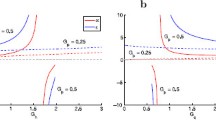Abstract
The synchrony vector, whose length stands for the vector strength (VS), is a means to quantify the amount of periodicity in a neuronal response to a given periodic signal, say, the stimulus. One usually chooses the input angular frequency and evaluates the synchrony vector as a weighted sum of exponentials taken at given experimental spike times of the neuronal response in combination with the driving input frequency. Given the experimental spike times, we replace the stimulus frequency by a variable probing frequency, study the synchrony vector in dependence upon this probing frequency, i.e., as a function of the frequency as a real variable, and exhibit both mathematically and experimentally a resonance behavior once the variable frequency is in the neighborhood of the stimulus frequency. Furthermore, a “resonating” VS is shown to be quite useful since one need not know the external frequency but can simply stick to the given spike times and analyze the ensuing resonance as the frequency varies, for example, to determine at the same time a “best” frequency and the corresponding VS. Finally, it is straightforward to determine the corresponding phase originating from, say, a delay as well.




Similar content being viewed by others
References
de Finetti B (1974) Theory of probability, vol I. Wiley, London
Gabbiani F, Koch C (1998) Principles of spike train analysis. In: Methods in neuronal modeling, 2nd edn. MIT Press, Cambridge, MA
van Hemmen JL (2013) Vector strength after Goldberg, Brown, and von Mises: biological and mathematical perspectives. Biol Cybern 107:385–396
van Hemmen JL, Longtin A, Vollmayr AN (2011) Testing resonating vector strength: auditory system, electric fish, and noise. Chaos 21:047508
Joris PX, Smith PH (2008) The volley theory and the spherical cell puzzle. Neuroscience 154:65–76
Joris PX, Louage DH, Cardoen L, van der Heijden M (2006) Correlation index: a new metric to quantify temporal coding. Hearing Res 216–217:19–30
Lamperti J (1966) Probability. Benjamin, New York
Author information
Authors and Affiliations
Corresponding author
Rights and permissions
About this article
Cite this article
van Hemmen, J.L., Vollmayr, A.N. Resonating vector strength: what happens when we vary the “probing” frequency while keeping the spike times fixed. Biol Cybern 107, 491–494 (2013). https://doi.org/10.1007/s00422-013-0560-8
Received:
Accepted:
Published:
Issue Date:
DOI: https://doi.org/10.1007/s00422-013-0560-8




